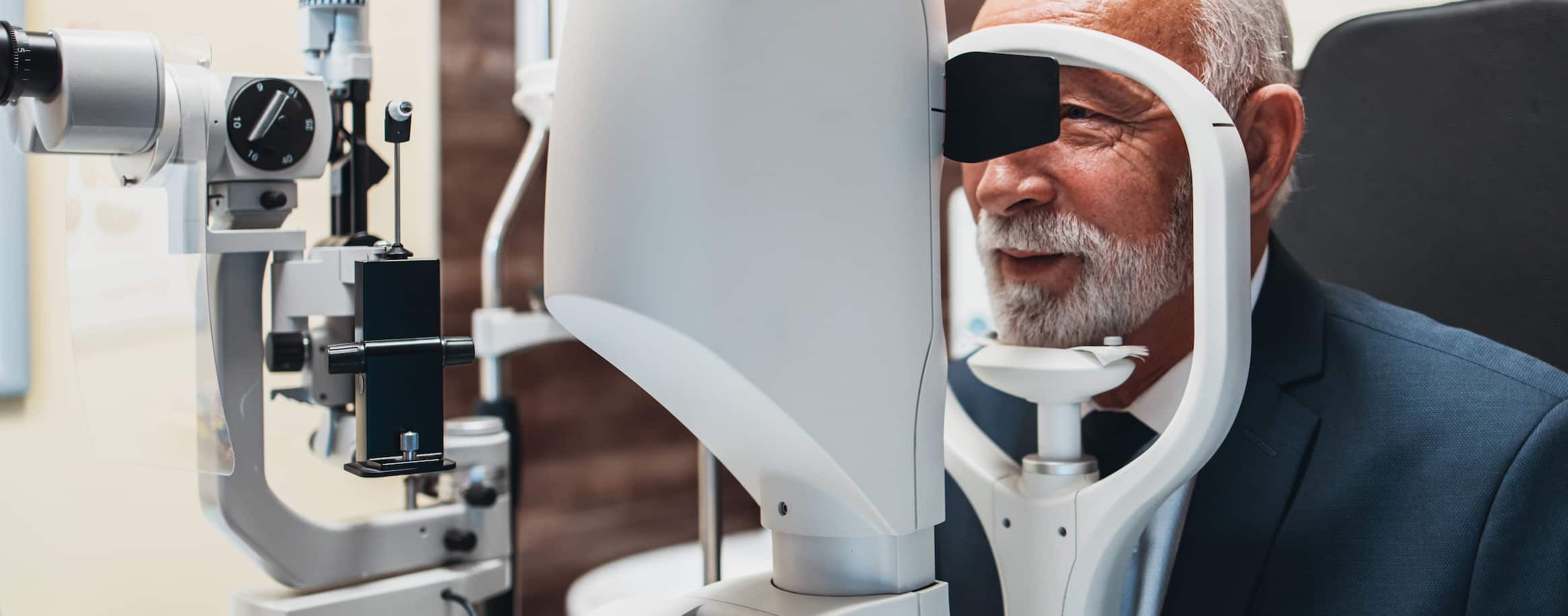The highly experienced cataract surgeons at Southern Eye Group are Board Certified Ophthalmologists and have treated thousands of cataract patients who had previously suffered from blurry and distorted vision. Patients who have poor vision from cataracts are easily treated with modern surgical techniques using lens implant options that can decrease or eliminate the need for glasses in many cases.
With several offices in Alabama, Florida and Mississippi, we serve patients throughout the Gulf Coast region.
- What are Cataracts
- What Causes Cataracts?
- Cataract Symptoms
- Treatment for Cataracts
- Who is a Candidate for Cataract Surgery?
- Traditional vs Laser Cataract Surgery
- Intraocular Lens Options
- Cataract Surgery: What to Expect
- Preparing for Cataract Surgery
- The Cataract Surgery Procedure
- Recovery After Cataract Surgery
- Cataract Surgery Risks and Complications
- Frequently Asked Questions About Cataract Surgery
What are Cataracts?
A cataract is a clouding (opacification) of the normally clear lens of the eye. Light passes through the eye’s lens, and the lens then focuses this light on the retina so you can see. When the lens is cloudy or opaque, it interferes with this passage of light and blurs vision.
There are several types of cataracts, the most common being:
- Nuclear cataracts that affect the main body of the lens
- Cortical cataracts that affect the edges of the lens, like spokes of a wheel
- Posterior subcapsular cataracts that affect the back of the lens centrally
There are some common misconceptions about cataracts. Cataracts are a change in the size, shape, and color of the human lens, not a film over the eye. Cataracts are usually a feature of aging, but can affect each eye independently. Most importantly, cataract blindness is usually reversible. In fact, cataract surgery is a safe, common, and simple procedure that can improve eyesight.
What Causes Cataracts?
The most common type of cataract is related to aging of the eye, with cataracts developing gradually over a period of years in later adult life. According to the
Trusted Source
Cataract data and statistics
National Eye Institute
Go to Source
National Eye Institute
, more than half of all Americans age 80 or older have cataracts or have had surgery to remove cataracts.
Cataracts, however, can also be caused by genetics; disease (such as diabetes); an eye injury or past eye surgery; smoking; or use of certain medications (such as corticosteroids). Cataracts may even exist at birth (congenital cataract). In some cases, cataracts may progress rapidly over a few months, but overall, it is difficult to predict how fast a cataract will develop for any given individual.
Cataract Symptoms
You may notice some changes in your vision if you have a cataract. The most common symptoms include:
- Cloudy vision
- Colors that seem faded
- Double vision (seeing two images instead of one)
- Increased sensitivity to light
- Needing brighter light to read
- Poor night vision
- Seeing
Trusted Source Cataracts Cleveland Clinic Go to Source halos around lights

Treatment for Cataracts
Surgery is the only permanent treatment for a cataract. Cataract surgery is a common and safe procedure with an excellent success rate. And best of all, when the surgery is done, you will regain clear vision and see better.
A cataract usually does not need to be removed right away, with timing generally guided by when the cataract is affecting your lifestyle. Actions such as updating your eyeglasses prescription, using brighter lighting, or wearing sunglasses may be helpful in minimizing the blurry vision and glare caused by a cataract. But when these measures no longer work––and when the cataract is interfering with your driving, favorite hobbies, and other daily activities––it might be time to consider having cataract surgery to improve your vision.

Who is a Candidate for Cataract Surgery?
If you have been diagnosed with cataracts and you are unsatisfied with your vision, you should seek out a cataract consultation with an eye care professional to see if you are a candidate for cataract surgery. While the average age for cataract surgery is 67, some people
Trusted Source
Geographic Variation in the Rate and Timing of Cataract Surgery Among US Communities
Kauh CY, Blachley TS, Lichter PR, Lee PP, Stein JD
Go to Source
need cataract surgery earlier
.
Traditional vs Laser Cataract Surgery
During traditional cataract surgery, the surgeon uses a handheld instrument called a microkeratome to incise, dismantle and suction out the cataract. During femtosecond laser assisted cataract surgery (FLACS), a laser is used to create the incisions and dismantle the lens under computer control before the surgeon suctions out the lens. In both instances, the surgeon places a lens implant. Both methods are safe and effective. We utilize the femtosecond laser to assist with specific cataract surgical patients to achieve the best results. Although traditional cataract surgery is typically covered by medical insurance, additional fees may apply for the use of laser technology, which is typically not covered by insurance.

Intraocular Lens Options
During cataract surgery, an artificial, intraocular lens (IOL) is used to replace the eye’s natural lens and repair cloudy vision. There are various types of IOLs that can be used to replace your natural lens, some of which can correct additional vision problems. Here are the three primary category of IOLs:
Standard, monofocal IOLs
These IOLs clarify vision blurred by cataracts and also improve distance vision.
Toric Astigmatism IOLs
Toric IOLs help correct astigmatism, as well as vision at one or multiple distances.
Presbyopia-correcting IOLs
These premium IOLs can correct vision at near, intermediate, and distance and can help free patients from corrective eyewear after cataract surgery. Additional fees apply for these lenses.
Light Adjustable Lens™
The Light Adjustable Lens (LAL) is the only IOL that can be adjusted after implantation for precise correction of both near and distance vision.

Cataract Surgery: What to Expect
Preparing for Cataract Surgery
The first step in preparing for cataract surgery is to undergo a thorough examination with an experienced ophthalmologist. During this meeting, if a cataract diagnosis is made you will discuss your options for cataract surgery with the eye doctor and arrive together at the best treatment plan for your unique needs.
Before cataract surgery, your cataract surgeon may ask you to use certain eye drops. You should arrive at our surgery center without any makeup, creams, or lotions on your face on the day of your procedure. You will need someone to drive you to and from surgery since you will have been given a sedative and will be wearing an eye patch, so please make arrangements for transportation.
Cataract Surgery Day: What to Expect
Cataract surgery is an outpatient procedure that takes only about 10-15 minutes per eye. We operate on each eye separately, with surgeries spaced one to two weeks apart.
Before cataract removal surgery begins, your eye will be made numb and a device will be used to gently hold your eyelids open so you won’t need to worry about blinking. You will be sedated to the point that this will not bother you.
To begin cataract surgery, the ophthalmologist makes a small incision in the eye. The cataract is broken up and removed using ultrasound technology in a process called phacoemulsification, then the natural lens is replaced with an intraocular lens (IOL). The incision for cataract surgery is so small that it will heal itself: no sutures are required.
Following cataract surgery, a
Trusted Source
Cataract Surgery
Mayo Clinic
Go to Source
protective shield
will be placed over your eye to protect the new lens as you heal. You will recover briefly here before being driven home by a friend or family member.
Cataract Surgery Recovery
To ensure a quick recovery, it is important that you take precautions and all medications according to your eye doctor’s instructions. You will need to wear the provided eye shield over your eye for a short time, as well as at bedtime to cover and protect your eye. Most cataract surgery patients return to their normal activities within a couple days to one week after surgery.

Cataract Surgery Risks and Complications
Cataract removal surgery is one of the most-performed operations in the world, and is considered to be generally safe and effective. However, there are risks and complications associated with every surgical procedure.
Risks of cataract surgery, though extremely rare,
Trusted Source
Cataract Surgery
American Academy of Ophthalmology
Go to Source
may include:
- Infection
- Inflammation or swelling
- Intraocular lens dislocation
- Drooping eyelid
- Vision loss
- Retinal detachment
Frequently Asked Questions About Cataract Surgery
Does insurance cover cataract surgery?
For individuals diagnosed with cataracts, traditional cataract surgery with standard IOLs is covered by most medical insurances, including Medicare. You may incur out-of-pocket costs if you opt for laser cataract surgery or to use a presbyopia correcting premium lens implant.
How much does cataract surgery cost?
The cost of cataract surgery varies based on several factors, such as:
- Benefits of your specific insurance plan, including deductible and co-insurance
- Whether you choose laser cataract surgery or traditional cataract surgery
- The type of Lens implant you need or choose
- If only one eye or both eyes need cataract treatment
During your consultation at our office, your eye doctor will conduct a medical evaluation and review the surgical options that will best meet your needs, lifestyle, and budget. For patients without insurance or with out-of-pocket expenses, we offer affordable financing solutions.
Can cataracts be prevented?
Cataracts are part of the natural aging process of the eye, and cannot be prevented. There may be, however, steps you can take keep your eyes healthy and delay the onset of cataracts, such as:
- Keeping diabetes under control
- Not smoking
Is cataract surgery painful?
Your eye will be fully numbed with anesthetic drops before the procedure. Some patients do report feeling some pressure during cataract surgery, but pain should not be part of your experience. Many patients don’t even remember the surgical event.

Contact Southern Eye Group
If you are experiencing symptoms of cataracts and want to learn more about cataract surgery and all the advanced laser and lens options available, contact us at 251-990-3937 to schedule a consultation today or request an appointment online.
1 National Eye Institute. Cataract data and statistics. Available: https://www.nei.nih.gov/learn-about-eye-health/resources-for-health-educators/eye-health-data-and-statistics/cataract-data-and-statistics. Accessed April 5, 2022.
2 Cleveland Clinic. Cataracts. Available: https://my.clevelandclinic.org/health/diseases/8589-cataracts Accessed April 5, 2022.
3 Kauh CY, Blachley TS, Lichter PR, Lee PP, Stein JD. Geographic Variation in the Rate and Timing of Cataract Surgery Among US Communities. JAMA Ophthalmol. 2016 Mar;134(3):267-76. doi: 10.1001/jamaophthalmol.2015.5322. PMID: 26720865; PMCID: PMC5767078. Available: https://www.ncbi.nlm.nih.gov/pmc/articles/PMC5767078/. Accessed April 5, 2022.
4 Mayo Clinic. Cataract Surgery. Available: https://www.mayoclinic.org/tests-procedures/cataract-surgery/about/pac-20384765. Accessed April 5, 2022.
5 American Academy of Ophthalmology. Cataract Surgery. Available: https://www.aao.org/eye-health/diseases/what-is-cataract-surgery. Accessed April 5, 2022.
The doctors at Southern Eye Group have either authored or reviewed and approved this content.
Page Updated:


